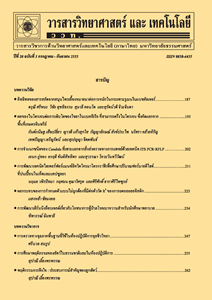การเปลี่ยนแปลงของสารทุติยภูมิในระหว่างการพัฒนาของกลีบเลี้ยงกระเจี๊ยบแดง (Hibiscus sabdariffa L.)
Main Article Content
Abstract
Abstract
Roselle (Hibiscus sabdariffa L.) is one of the medicinal plants in which the calyces are used for the treatment of various diseases. In order to determine the suitable harvesting time for medicinal purposes, calyx development and changes in secondary metabolites of the calyx during development were examined. Two accessions of dark red and orange-red calyx roselle, HS005 and HS013, respectively, were cultivated. The full bloomed flowers were tagged daily and the calyces were harvested at 5, 10, 15, 20, 25, 30, 35 and 40 days after flowering (DAF). Results showed that calyx of both accessions rapidly developed during 5 to 20 DAF then only slight changes occurred. The contents of secondary metabolites in HS005 were higher than those in HS013, however, secondary metabolite changes during calyx development exhibited a similar pattern in both accessions. Total anthocyanin content was high at 5 DAF then gradually declined. The contents of total phenolic and total flavonoid continuously increased and the highest contents of both secondary metabolites were obtained at 30 DAF. DPPH radical scavenging capacities were not significantly different among the treatments. Based on these results, the appropriate time to harvest calyx for medicinal used was 30 DAF.
Keywords: calyx; roselle; anthocyanin; phenolic; flavonoid; DPPH radical scavenging capacity
Article Details
References
[2] Wisetmuen, E., Pannangpetch, P., Kongyingyoes, B., Kukongviriyapan, U., Yutanawiboonchai, W. and Itharat, A., 2013, Insulin secretion enhancing activity of roselle calyx extract in normal and streptozotocin induced diabetic rats, Pharm. Res. 5: 65-70.
[3] Sireeratawong, S., Itharat, A., Khonsung, P., Lertprasertsuke, N. and Jaijoy, K., 2013, Toxicity studies of the water extract from the calyces of Hibiscus sabdariffa L. in rats, Afr. J. Tradit. Complement. Altern. Med. 10: 122-127.
[4] Wong, P.K., Yusof, S., Ghazali, H.M. and Man, Y.B.C., 2002, Physico-chemical characterization of roselle (Hibiscus sabdariffa L.), Nutr. Food Sci. 32: 68-73.
[5] Hussein, R.M., Shahein, Y.E., El Hakim, A.E. and Awad, H.M. 2010, Biochemical and molecular characterization of three colored types of roselle (Hibiscus sabdariffa L.), J. Am. Sci. 6: 726-733.
[6] Mohd-Esa, N., Hern, F.S., Ismail, A. and Yee, C.L., 2010, Antioxidant activity in different parts of roselle (Hibiscus sabdariffa L.) extracts and potential exploitation of the seeds, Food Chem. 122: 1055-1060.
[7] ชนันดา ศรีบุญไทย, ภาณุมาศ ฤทธิไชย, เยาวพา จิระเกียรติกุล และพรชัย หาระโคตร, 2559, พัฒนาการและการสุกแก่ของเมล็ดพันธุ์กระเจี๊ยบแดง, ว.วิทยาศาสตร์และเทคโนโลยี 24: 333-341.
[8] ภาณุมาศ ฤทธิไชย, ปิยาภัทร์ เข็มวิชัย และเยาวพา จิระเกียรติกุล, 2558, การพัฒนาของดอกและฤทธิ์ต้านอนุมูลอิสระในดอกพระจันทร์ (Ipomoea alba L.), ว.วิทยาศาสตร์และเทคโนโลยี 23: 497-506.
[9] อดิศร จำรูญ, พรรณิภา ยั่วยล และบุษรา จ้อยร่อย, 2558, การวิเคราะห์ฤทธิ์ต้านอนุมูลอิสระในกล้วยหินและกล้วยเล็บมือนาง, ว.พืชศาสตร์สงขลานครินทร์ 2: 38-42.
[10] Christian, K.R. and Jackson, C.J., 2009, Changes in total phenolic and monomeric anthocyanin composition and antioxidant activity of three varieties of sorrel (Hibiscus sabdariffa) during maturity, J. Food Compos. Anal. 22: 663-667.
[11] Chumsri, P., Sirichote, A. and Itharat, A., 2008, Studies on the optimum conditions for the extraction and concentration of roselle (Hibiscus sabdariffa Linn.) extract, Songklanakarin J. Sci. Technol. 30: 133-139.
[12] Lee, J., Durst, R.W. and Wrolstad, R.E., 2005, Determination of total monomeric anthocyanin pigment content of fruit juices, beverages, natural colorants, and wines by the pH differential method: collaborative study, J. AOAC Int. 88: 1269-1278.
[13] Zhu, H., Wang, Y., Liu, Y., Xia, Y. and Tang, T., 2010, Analysis of flavonoids in Portulaca oleracea L. by UV-Vis spectrophotometry with comparative study on different extraction technologies, Food Anal. Methods. 3: 90-97.
[14] Folin, O. and Ciocalteu, V., 1927, On tyrosine and tryptophane determinations in proteins, J. Biol. Chem. 73: 627-650.
[15] Yamasaki, K., Kashimoto, A., Kokusenya, Y., Miyamoto, T. and Sato, T., 1994, Electrochemical method for estimating the antioxidatice effect of methanol feeding, Enzyme Microb. Tech. 36: 133-138.
[16] สุภางค์ เรืองฉาย, 2552, การพัฒนาน้ำพริกมะขามผสมกระเจี๊ยบ, ว.วิชาการ มหาวิทยาลัยหอการค้าไทย 29: 88-101.
[17] Hu, Q.P. and Xu, J.G., 2011, Profiles of carotenoids, anthocyanins, phenolics, and antioxidant activity of selected color waxy corn grains during maturation, J. Agric. Food Chem. 59: 2026-2033.
[18] Oloyede, F.M., Oloyede, F.A. and Obuotor, E.M., 2013, Effect of plant maturity on the antioxidant profile of Amaranthus cruentus L. and Celosia argentea L., Bull. Env. Pharmacol. Life Sci. 2: 18-21.
[19] Policegoudra, R.S., Kumar, M.H.S. and Aradhya, M.S., 2007, Accumulation of bioactive compounds during growth and development of mango ginger (Curcuma amada Roxb.) rhizome, J. Agric. Food Chem. 55: 8105-8111.
[20] Kouakou, T.H., Konkon, N.G., Ayolié, K., Obouayeba, A.P., Abeda Z.H. and Koné, M., 2015, Anthocyanin production in calyx and callus of roselle (Hibiscus sabdariffa L.) and its impact on antioxidant activity, J. Pharmacogn. Phytochem. 4: 9-15.

